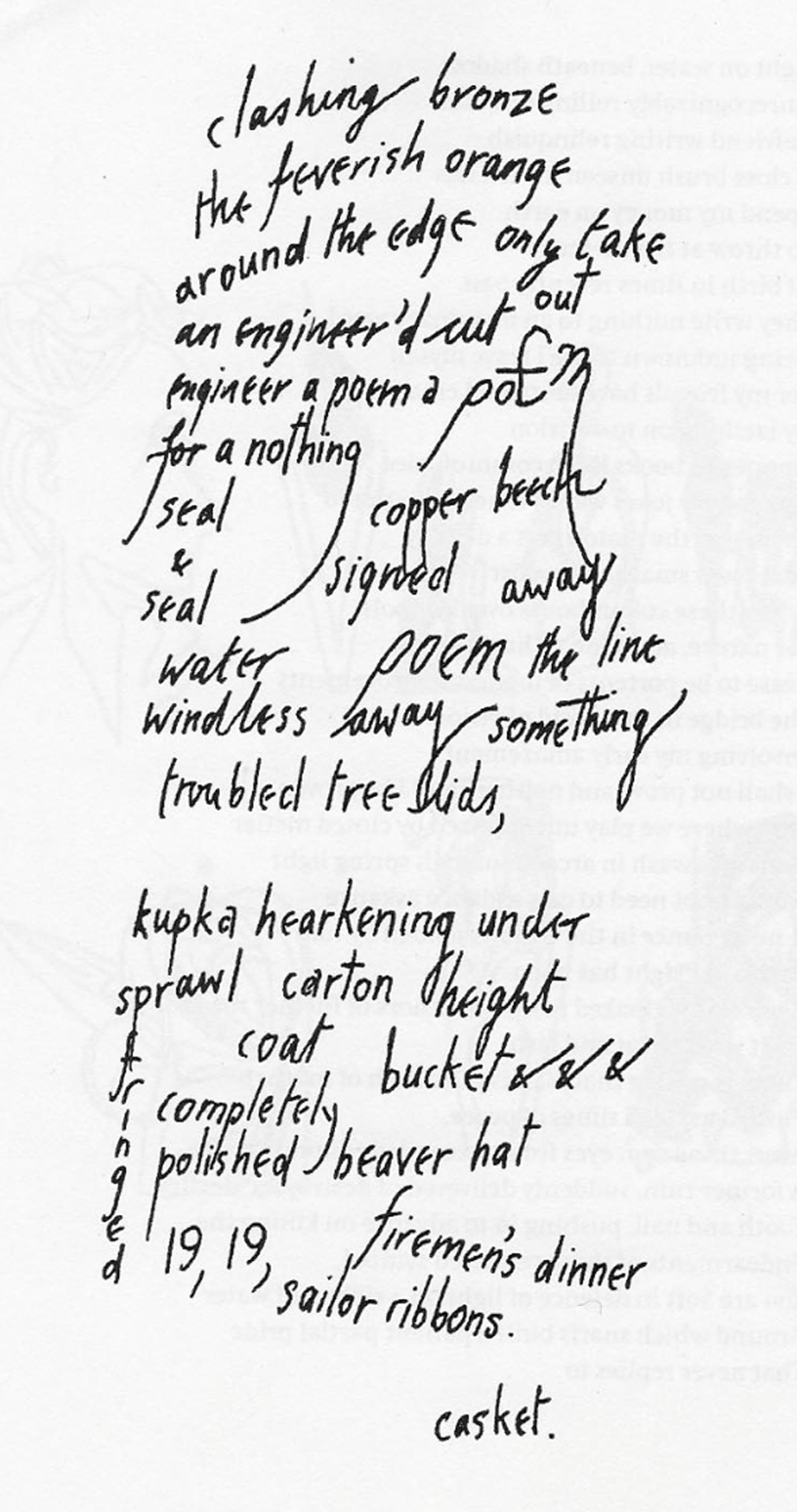The drawn poem on page 28 of Implacable Art is loose; its calligraphy varies in size; the words and symbols are mostly legible and made up of letters. The poem is centred in the middle of the page, in the shape of a tall unfastened rectangle or column. The letters and words sit and push out beyond its form making the edges of the poem hard to define. The poem is descriptive but contains no pronouns, no mention of the poet, or any reflective content. Instead, words are roughly mounted together in a lively drawing that provokes material and changing associations between them. Unlike the poem ‘Europa’, which is printed on the opposite page and declares that ‘what does not help | is the piling up | of pretence’,1 as well as almost every typed poem in the collection, this handwritten poem contains no opinions, no justifications. Instead, with its flowing script and performative symbols the poem moves within a language space unconfined by textual and self- justification.
The first few lines of the poem,2 as I see them, read:
clashing bronze the feverish orange around the edge only take an engineer’s cut out engineer a poem a3
This last phrase ‘engineer a poem a’ is followed in the drawing by a larger word that could be ‘poEM’ but the ‘p’ looks like a spoon, the E a £ sign and the M is decorative and grand, its right stem reaching down through the words beneath. The word may be read as ‘poEM’ or ‘po£M’ or even as ‘pot’. In this way, the word ‘poem’ morphs into ‘pot of money’, as the language, drawn, proliferates various sets of meanings, spontaneously exceeding its own limits. This morphing gives the poem a live quality as if it is in dialogue with itself as a live object. The words that surround this part word, part pictograph (po£M) refer to this mutation as well as being engaged in their own acts of reflection, repetition and transformation: ‘engineer’d cut’, ‘engineer a poem’, ‘seal &’, ‘seal water’, ‘signed away’, ‘copper signed’ and ‘for a nothing’. Is there a suggestion that poetry risks being confined, overly engineered, packaged and transactional, like money, ‘signed away’, its meaning sealed ‘for a nothing’? A definitive meaning is not possible, is as good as nothing. The poem-as-transaction risks losing its power, becoming a cut-out, dulling the clashing bronze and feverish orange of the edges that this drawn poem animates.
The poem’s opening phrase ‘clashing bronze’ evokes industry and matter in formation. Bronze is the metal of money, weaponry, statues; the poem and its words grind against metal burning ‘feverish orange’, in an industrial process that melts edges and form. Despite the global (often militarised) process of extraction and dissolution of metal (or stone, or fur) for bourgeois refinement – exemplified by the ‘completely polished beaver hat’ – the poem remains frayed or ‘fringed’ as if the ‘feverish orange around the edge’ is where the force of the poem is, and where extreme feelings and extractive processes that bind and cut out can be found, changing, feverish, always on the edge.
This poem is reflective of feminist practices established by the Language poets, particularly Lyn Hejinian (1941-) whom Mendelssohn was anthologised alongside in 2004.4 For Hejinian, the poem does not have edges but boundaries, and each boundary is a conjunction: ‘and’, ‘or’, ‘but’. Considering how boundaries, when too rigid, are detrimental in social and economic life, Hejinian proposed a poetics that subverts received logocentric values in much Western poetry and their binding nature. The poem, understood in this way, is not fixed or totalising. Instead its boundaries are open and changing and therefore not, as Hejinian writes, ‘bound by the kind of reason that plows its way to authority’.5 The association between reason and authority evokes Mendelssohn’s conflicted relationship to reason within her poems, which is articulated through endless contradictions, justifications, and defences, arguably in response to language’s structural enmeshment with authority and particularly with regards to Mendelssohn’s own (grievous) encounters with authority. This handwritten poem conveys Hejinian’s method by loosening its edges, giving the impression of words and symbols trying to break free. The conjunction ‘&’ in the lower half of the poem marches out of the frame, saluting away from the poem’s interior, even pulling it apart as the ‘t’ at the end of ‘bucket’ is stretched forward. The conjunction attempts to drag the bucket into the white space of the page, playfully suggesting a place in which language might be free of justified textual ‘ribbons’ and ‘what does not help… the piling up of pretence’.
Notes
- ‘Europa’, Implacable Art, p.29. [^]
- I chose to refer to this handwritten poem as a poem for the sake of my argument but it would also feel appropriate to refer to it as a picture. [^]
- I am reading the words roughly from left to right although there are clear suggestions that the reading doesn’t have to take this direction. [^]
- The anthology was Vanishing Points: New Modernist Poems, eds. Rod Mengham and John Kinsella (Cambridge, UK / Applecross, Western Australia: Salt, 2004). [^]
- Lyn Hejinian, The Language of Inquiry, (University of California Press: 2000), p. 351. [^]
Acknowledgements
Image reprinted with kind permission of the Mendelssohn estate.
Competing Interests
The author has no competing interests to declare.
